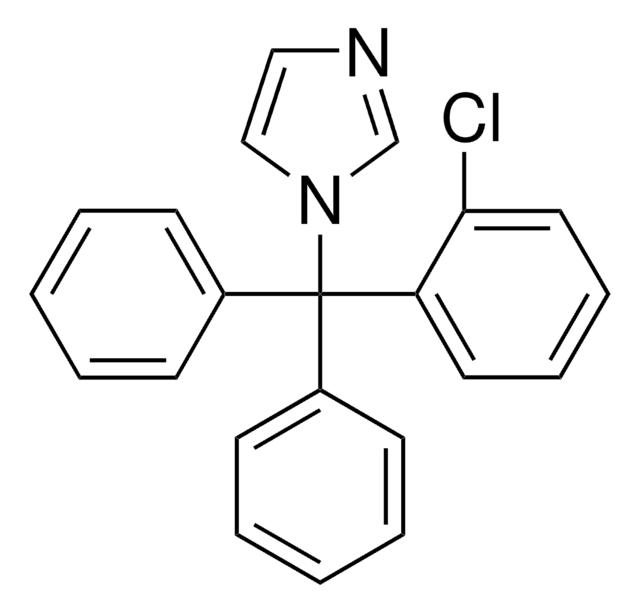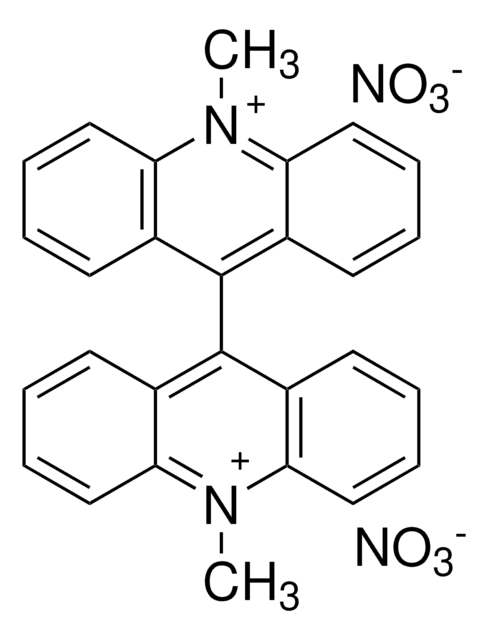T8543
O-Tricyclo[5.2.1.02,6]dec-9-yl dithiocarbonate potassium salt
≥95%, solid
Synonym(s):
D609
Sign Into View Organizational & Contract Pricing
All Photos(2)
About This Item
Empirical Formula (Hill Notation):
C11H15KOS2
CAS Number:
Molecular Weight:
266.46
EC Number:
MDL number:
UNSPSC Code:
41106300
PubChem Substance ID:
NACRES:
NA.77
Recommended Products
biological source
synthetic (organic)
Quality Level
Assay
≥95%
form
solid
color
off-white to yellow
solubility
H2O: soluble 50 mg/mL, clear to slightly hazy, colorless to faintly yellow
acetone: easily soluble
diethyl ether: insoluble
hydrocarbons: insoluble
SMILES string
[K]SC(=S)OC1CC2CC1C3CCCC23
InChI
1S/C11H16OS2.K/c13-11(14)12-10-5-6-4-9(10)8-3-1-2-7(6)8;/h6-10H,1-5H2,(H,13,14);/q;+1/p-1/t6-,7?,8?,9-,10?;/m1./s1
InChI key
IGULCCCBGBDZKQ-HJPGVBIPSA-M
Application
D609 has been used as a phosphatidylcholine-specific phospholipase C (PC-PLC) inhibitor in mouse bone marrow derived monocytes. D609 has also been reported to significantly reduce the elevated levels of phosphatidylethanolamine binding protein 1 (PEBP1) in apolipoprotein E-/- mice.
Biochem/physiol Actions
D609 can block the production of diacylglycerol (DAG) in the cell. D609 functions by inhibiting the phospholipase C-mediated hydrolysis of the phosphate bond present in phosphatidylcholine and other glycerophospholipids.
Phosphatidylcholine-specific phospholipase C (PLC) and HIV-1 inhibitor. Xanthogenate derivative with in vitro anti-tumor activity.
Preparation Note
O-Tricyclo[5.2.1.02,6]dec-9-yl dithiocarbonate or D609 is soluble in water at 50 mg/ml and yields a clear to slightly hazy, colorless to light yellow solution. It is also soluble in acetone. However, it is insoluble in ether and hydrocarbons.
Alcoholic solutions should not be prepared due to the possibility of transesterification. The product is very labile in solution (1.5 days half-life in tissue culture medium) and is readily hydrolyzed below pH 6.0. Hence, solutions should be prepared immediately before use and unused solutions must be discarded. For tissue culture preparations, the media should be buffered to pH 6.0-7.5. HEPES buffer must not be used as it renders this product toxic.
Alcoholic solutions should not be prepared due to the possibility of transesterification. The product is very labile in solution (1.5 days half-life in tissue culture medium) and is readily hydrolyzed below pH 6.0. Hence, solutions should be prepared immediately before use and unused solutions must be discarded. For tissue culture preparations, the media should be buffered to pH 6.0-7.5. HEPES buffer must not be used as it renders this product toxic.
Storage Class Code
11 - Combustible Solids
WGK
WGK 3
Flash Point(F)
Not applicable
Flash Point(C)
Not applicable
Personal Protective Equipment
dust mask type N95 (US), Eyeshields, Gloves
Choose from one of the most recent versions:
Already Own This Product?
Find documentation for the products that you have recently purchased in the Document Library.
Li Wang et al.
The Journal of physiology, 591(20), 5005-5015 (2013-08-21)
We previously found that phosphatidylcholine-specific phospholipase C (PC-PLC) was a key inducing element of atherosclerosis, and might negatively regulate human umbilical vein endothelial cell (HUVEC) autophagy. To further investigate the mechanism of PC-PLC action, we initially identified phosphatidylethanolamine binding protein
Laura Abalsamo et al.
Breast cancer research : BCR, 14(2), R50-R50 (2012-03-21)
Acquisition of mesenchymal characteristics confers to breast cancer (BC) cells the capability of invading tissues different from primary tumor site, allowing cell migration and metastasis. Regulators of the mesenchymal-epithelial transition (MET) may represent targets for anticancer agents. Accruing evidence supports
Chiharu Fujihara et al.
Journal of cellular physiology, 234(5), 7149-7160 (2018-10-30)
Fibroblast growth factor-2 (FGF-2) stimulates periodontal regeneration by a broad spectrum of effects on periodontal ligament (PDL) cells, such as proliferation, migration, and production of extracellular matrix. A critical factor in the success of periodontal regeneration is the rapid resolution
Ning Tang et al.
Journal of orofacial pain, 23(2), 167-173 (2009-06-06)
To evaluate possible effects of the intracerebroventricular (icv) injection of either O-Tricyclo [5.2.1.0(2,6)] dec-9-yl dithiocarbonate potassium salt (D609), a potent antioxidant and inhibitor of phosphatidylcholine specific phospholipase C (PtdCho-PLC) and acid sphingomyelinase (ASMase), or the spin trap/free radical scavenger N-tert-Butyl-alpha-phenylnitrone
Lu Zhang et al.
Arteriosclerosis, thrombosis, and vascular biology, 30(3), 411-418 (2010-02-09)
Atherosclerosis is considered to be a chronic inflammatory disease. Previous research has demonstrated that phosphatidylcholine-specific phospholipase C (PC-PLC) plays critical roles in various inflammatory responses. However, the association between PC-PLC and atherosclerosis is undetermined. Therefore, we sought to investigate whether
Our team of scientists has experience in all areas of research including Life Science, Material Science, Chemical Synthesis, Chromatography, Analytical and many others.
Contact Technical Service







